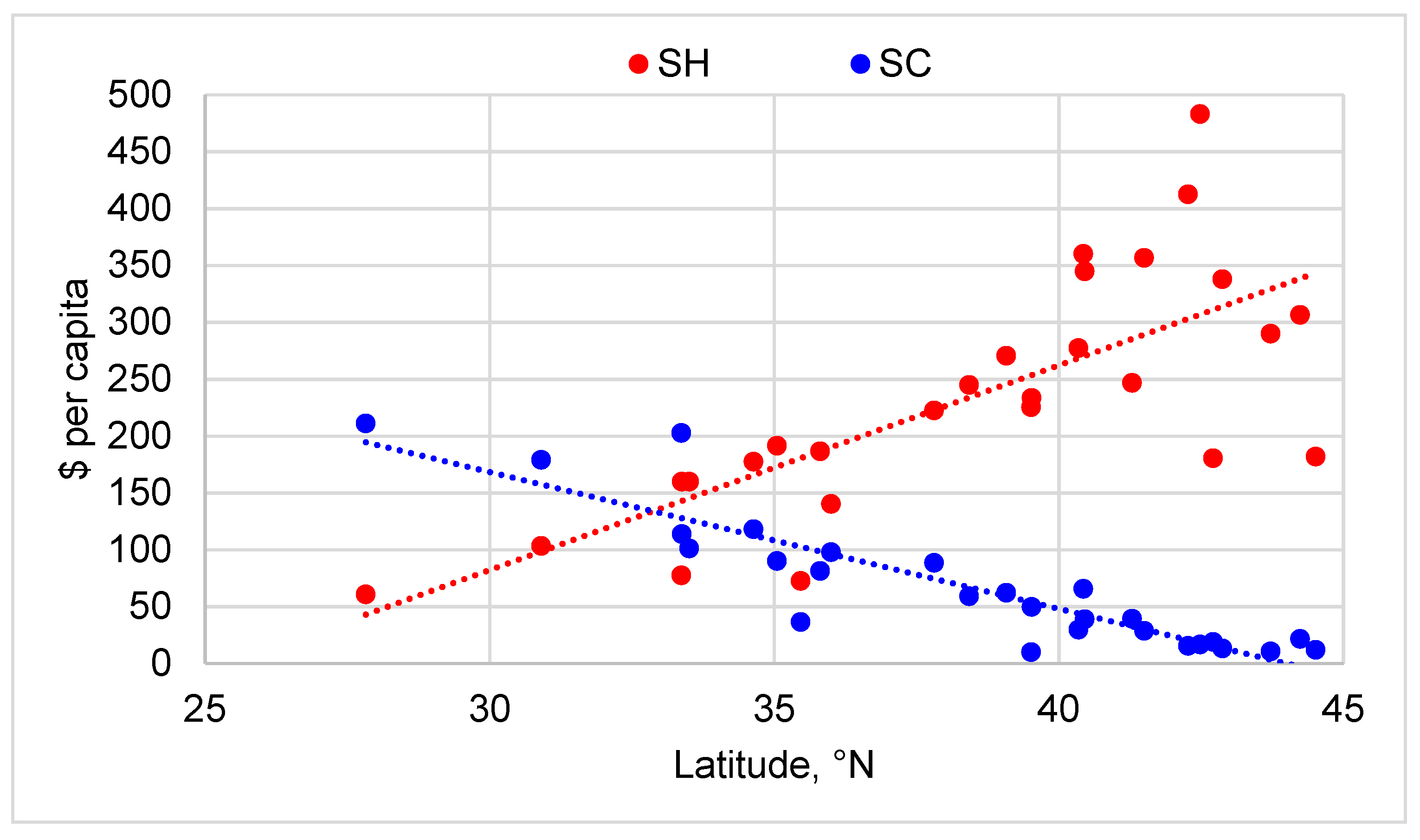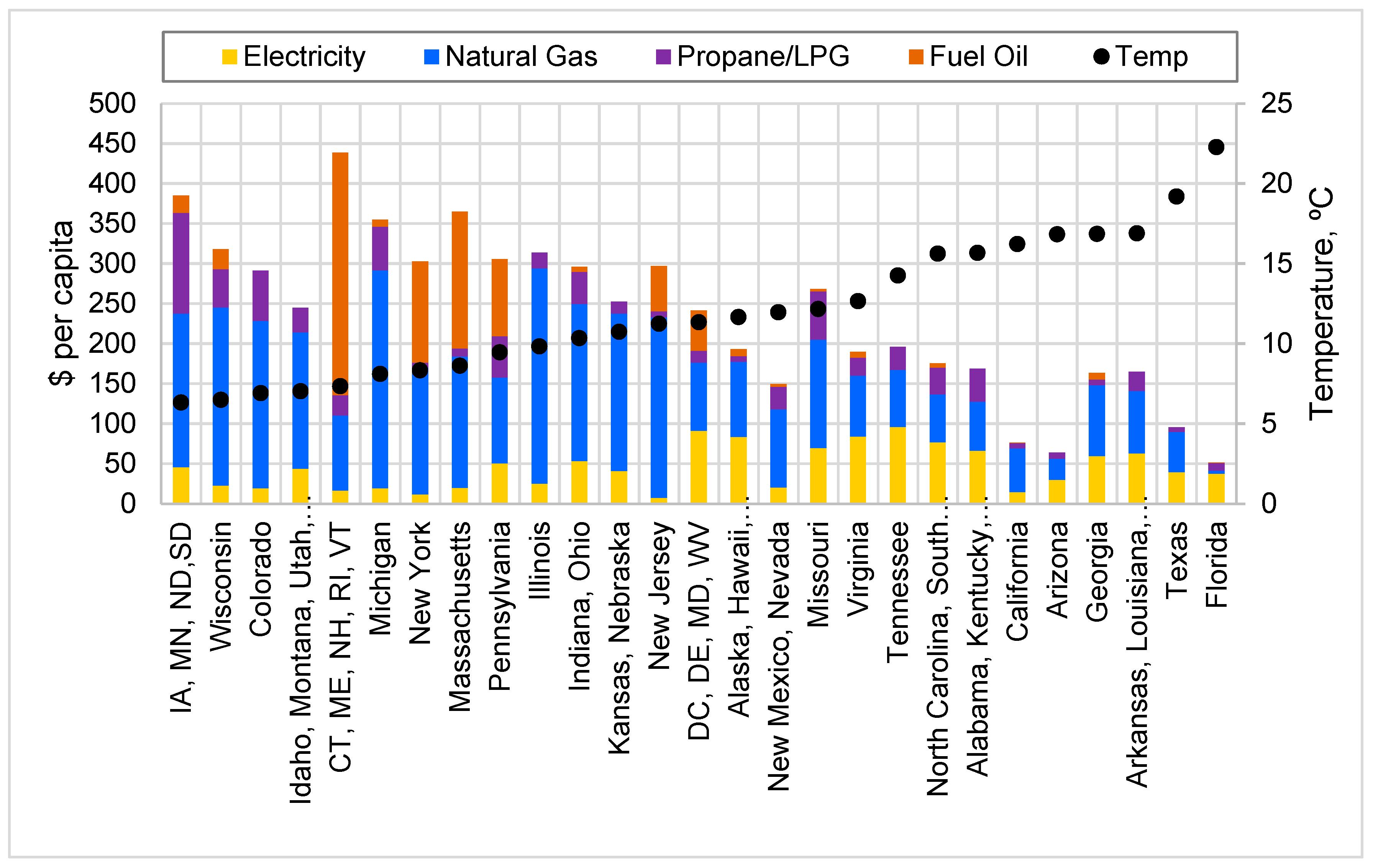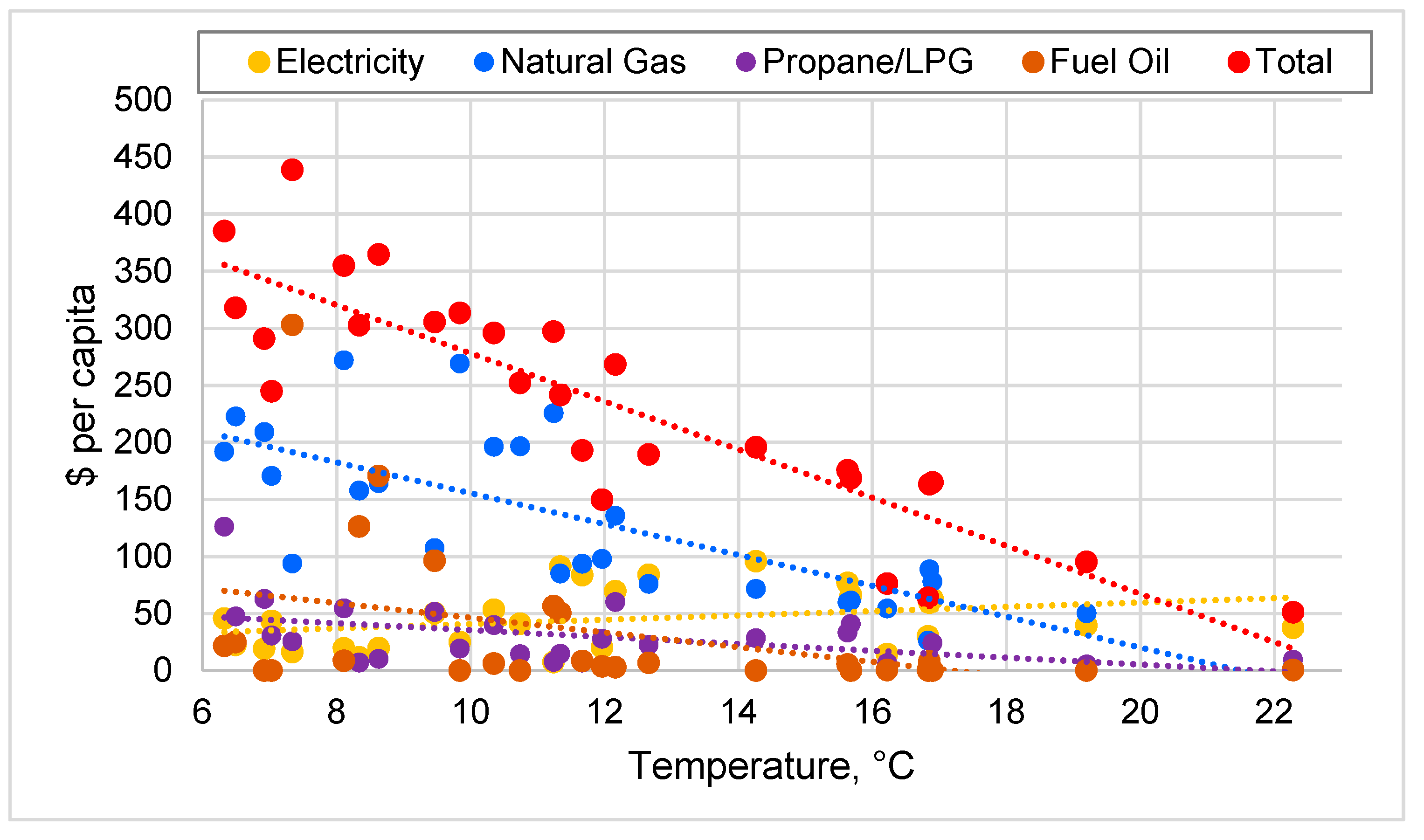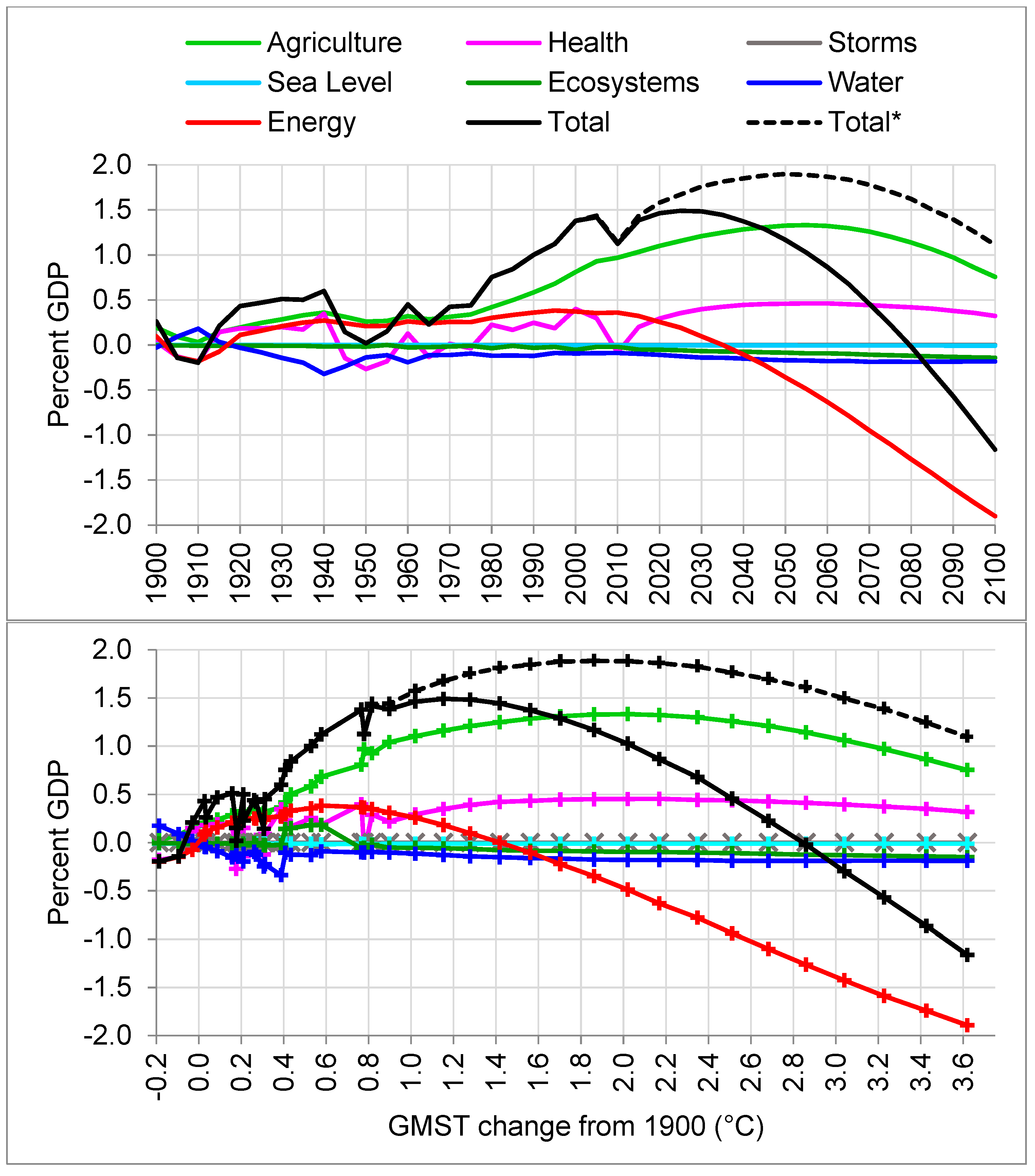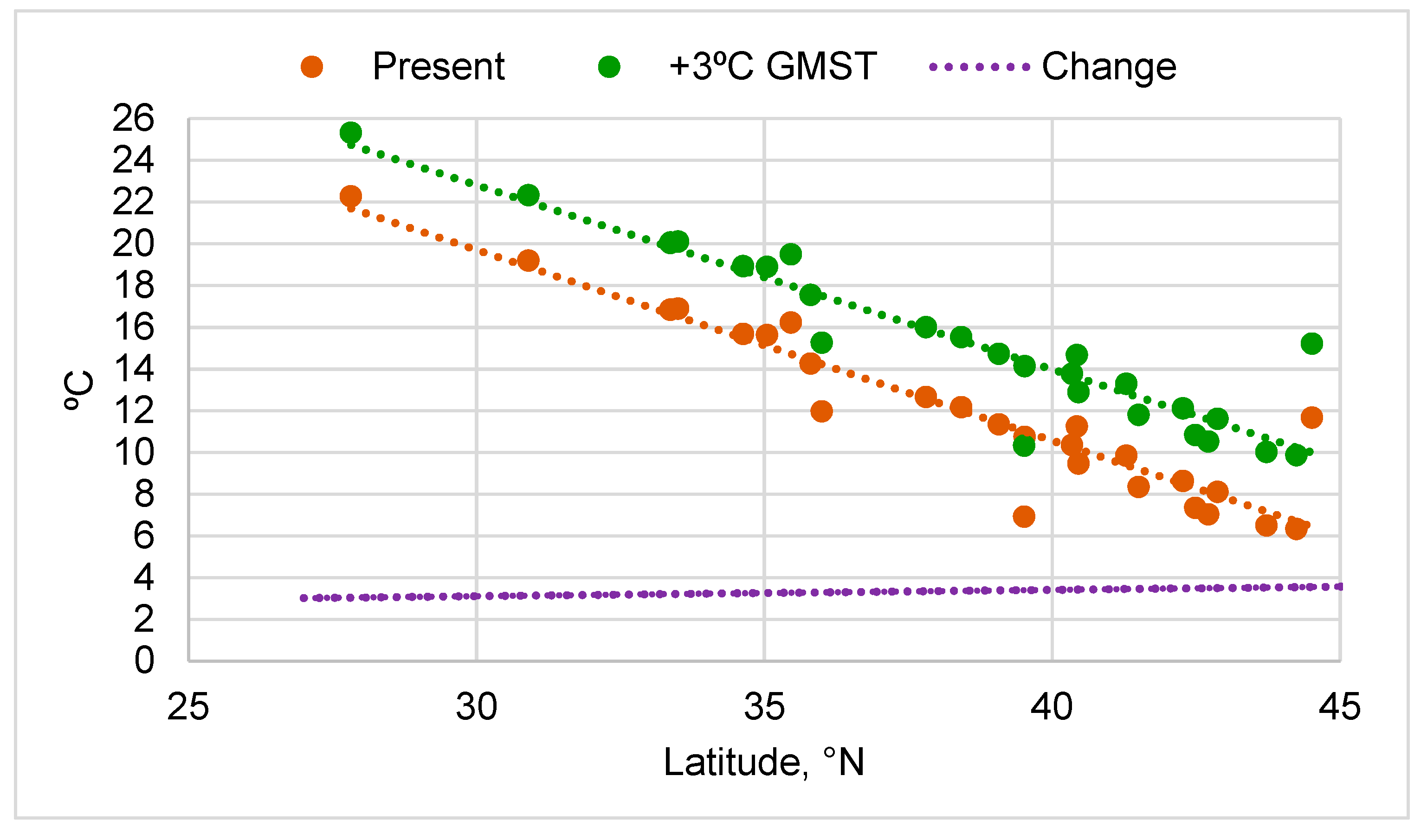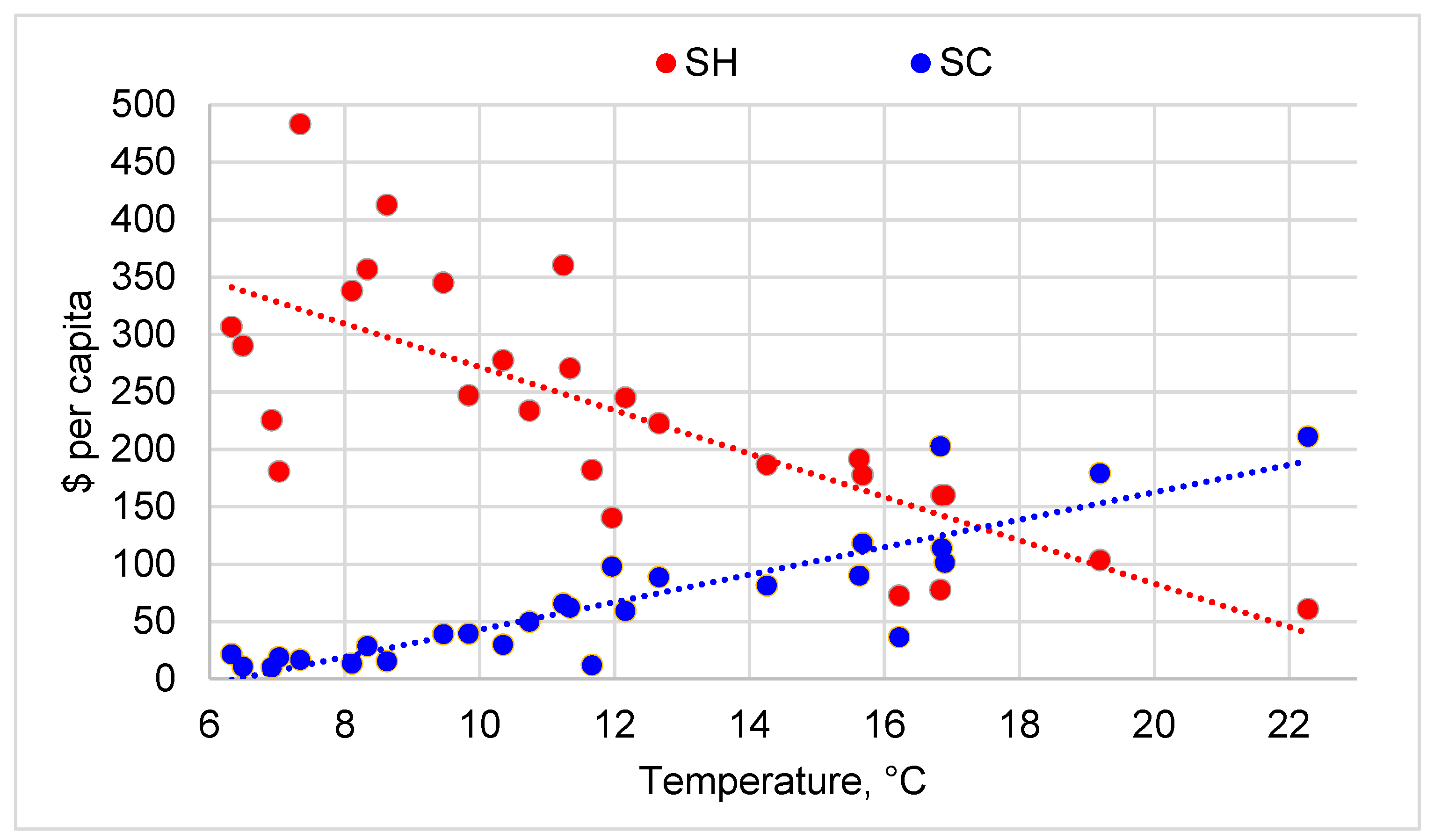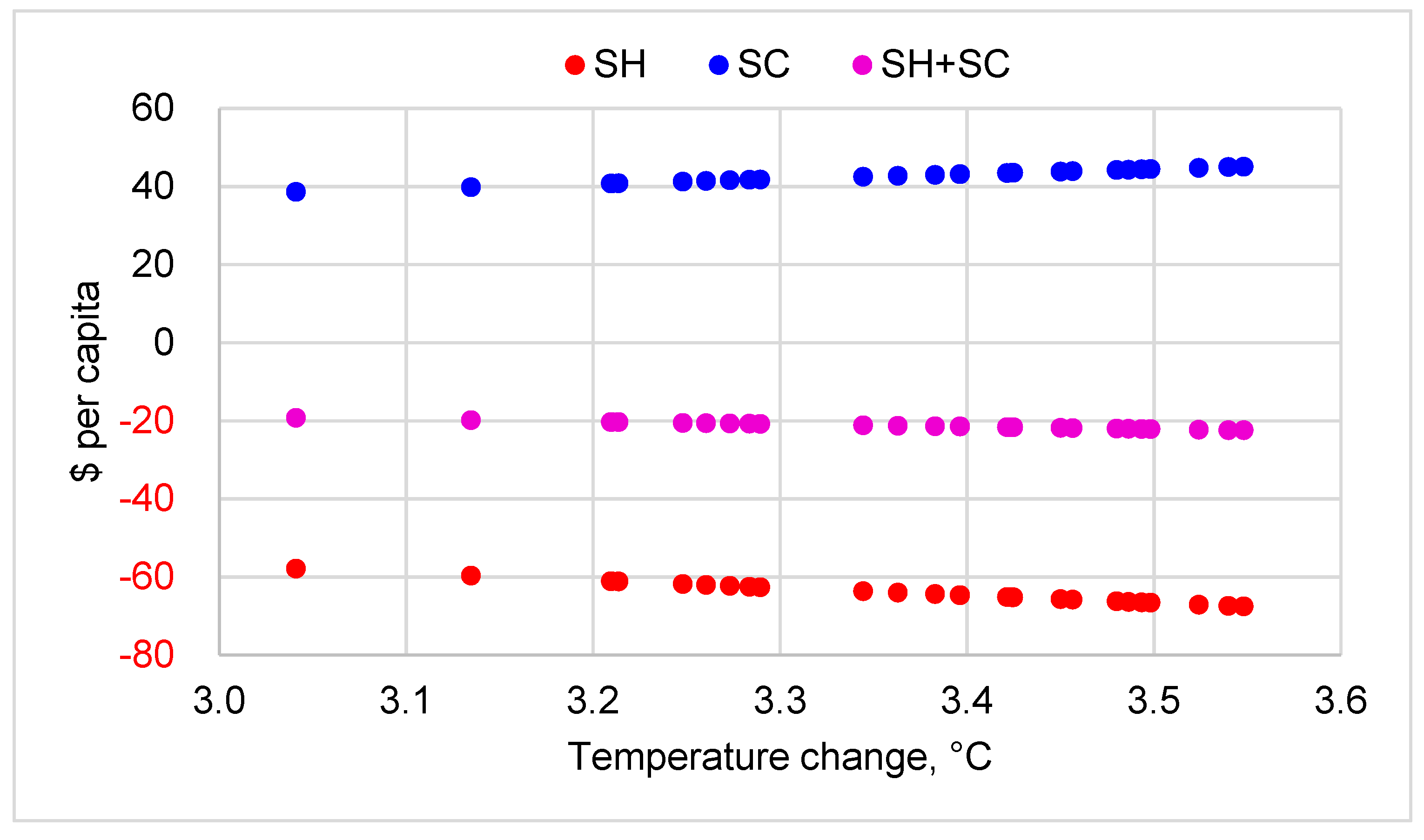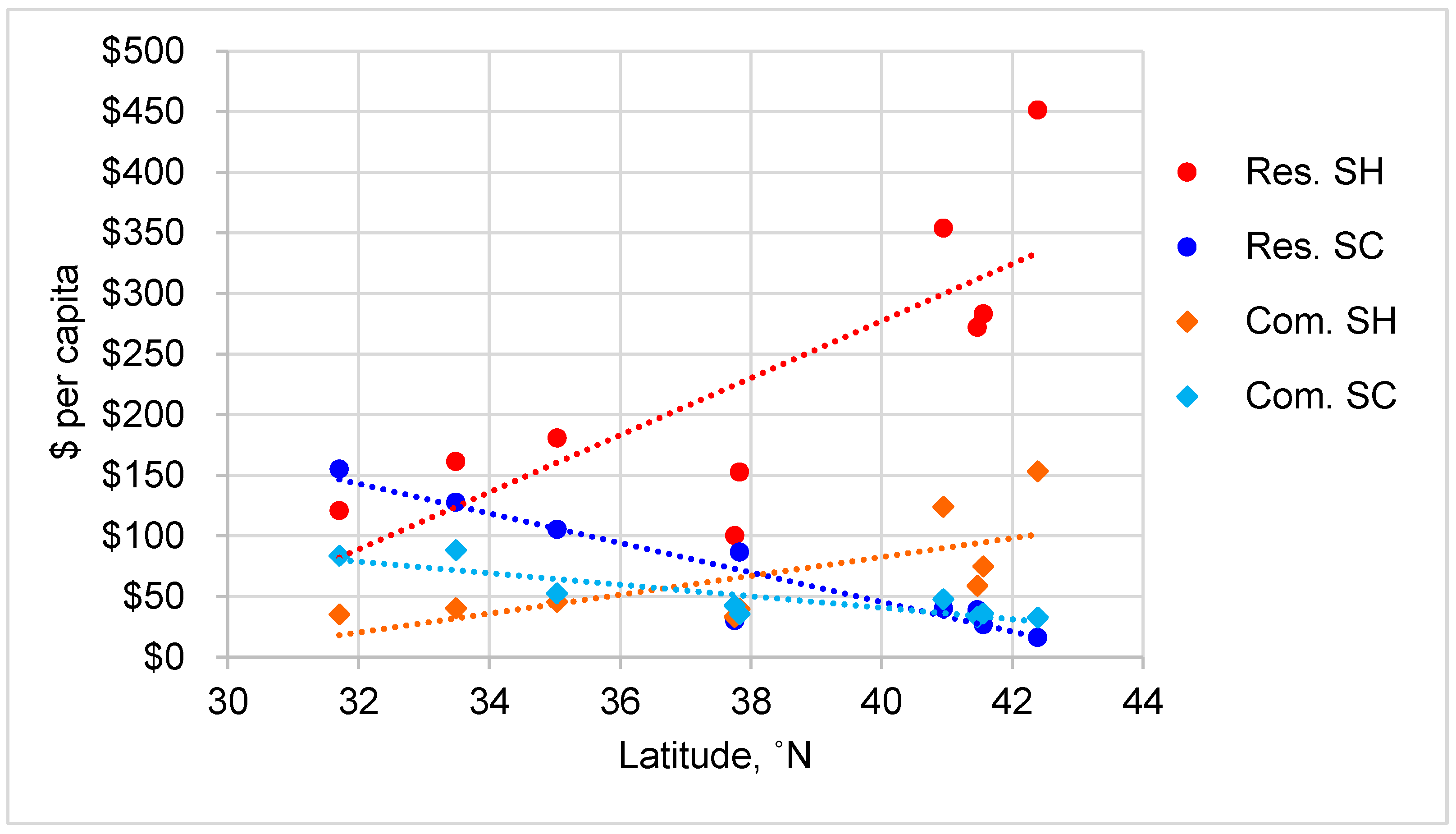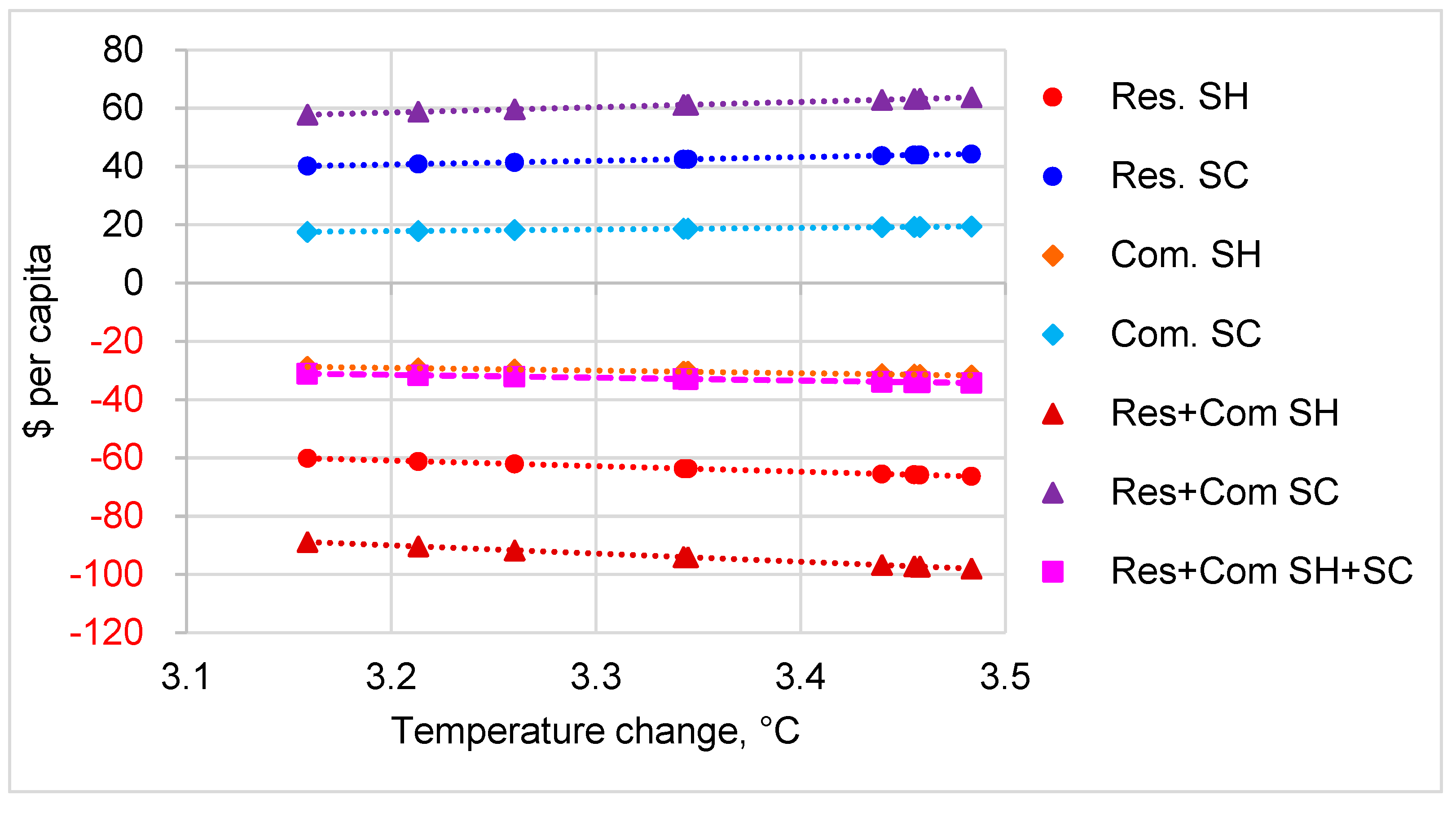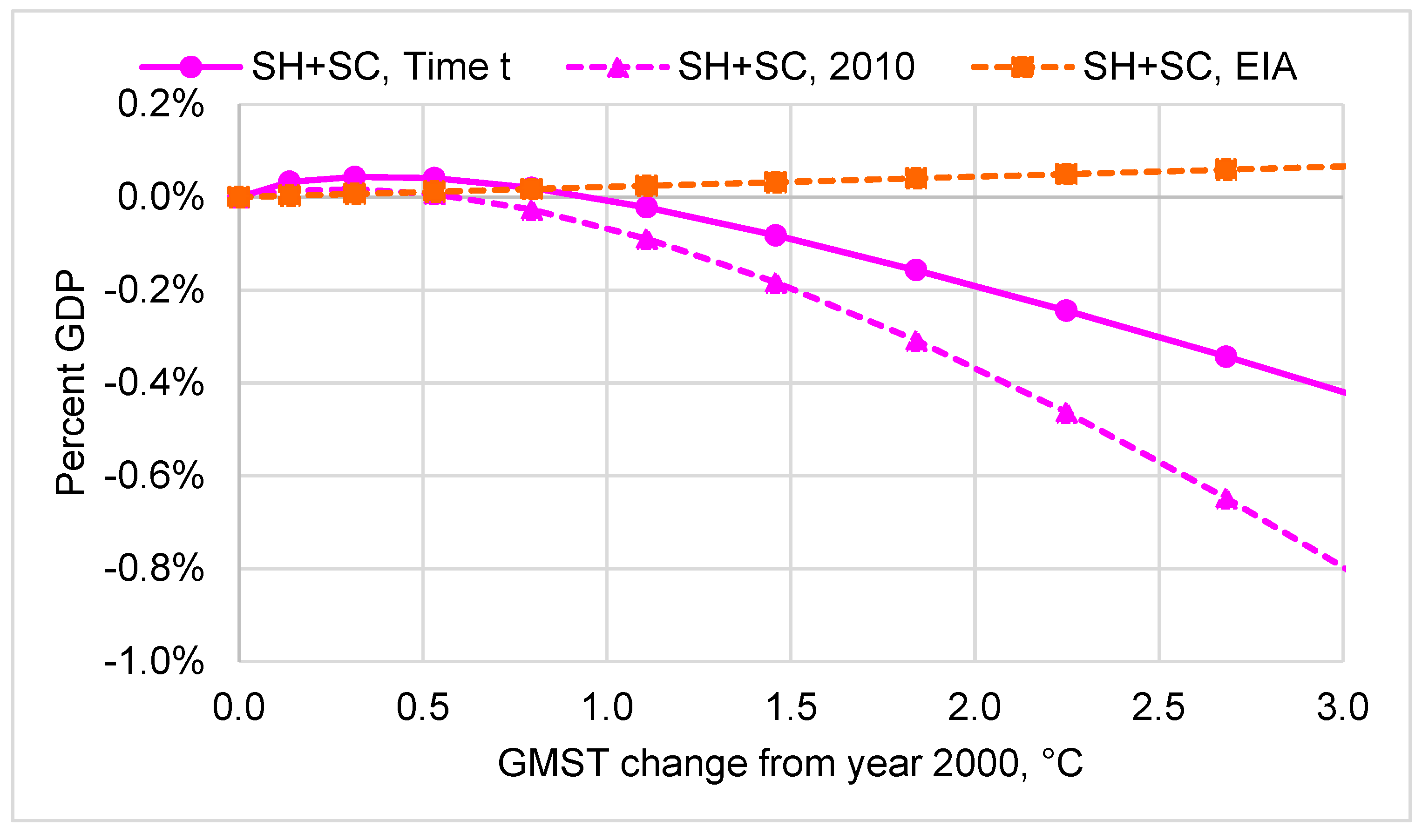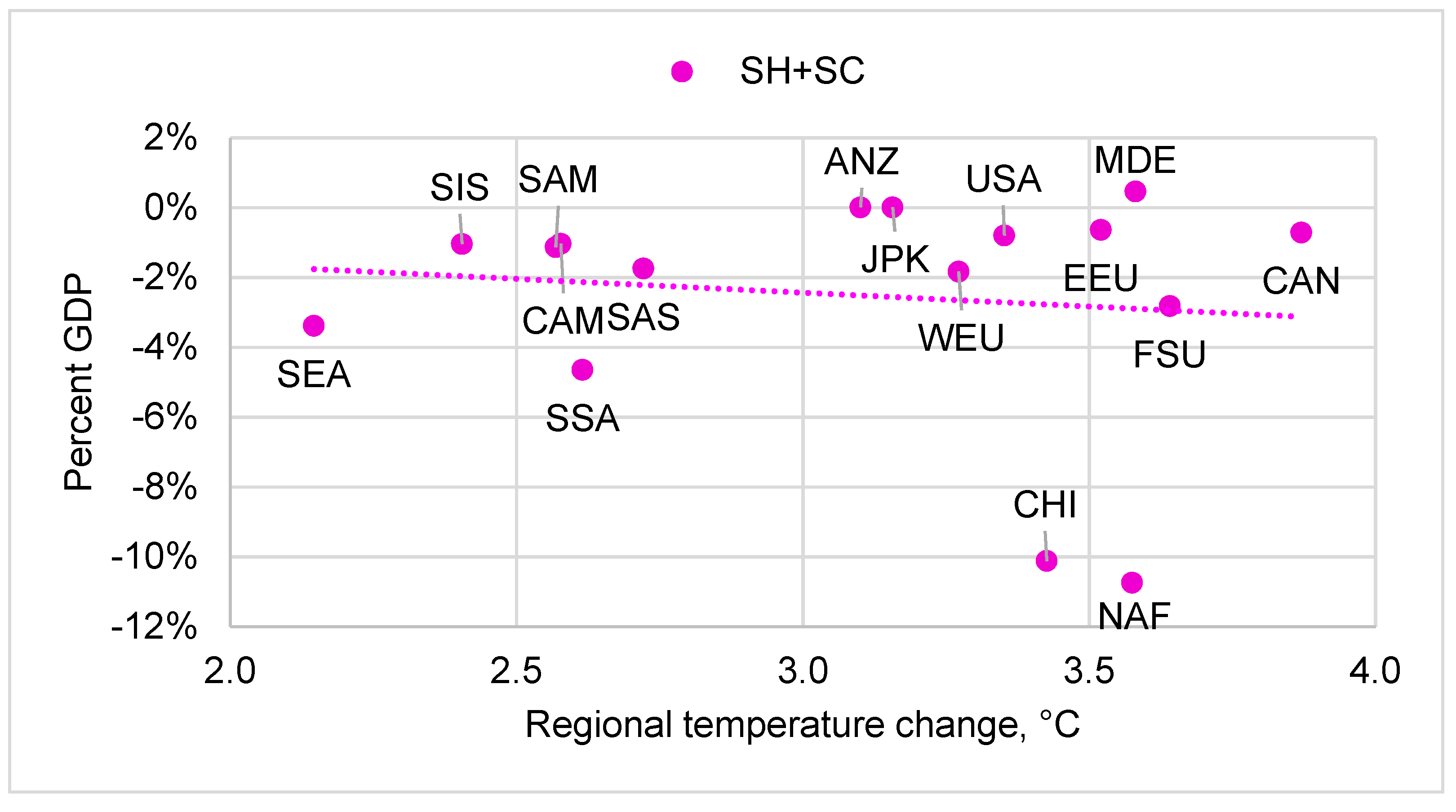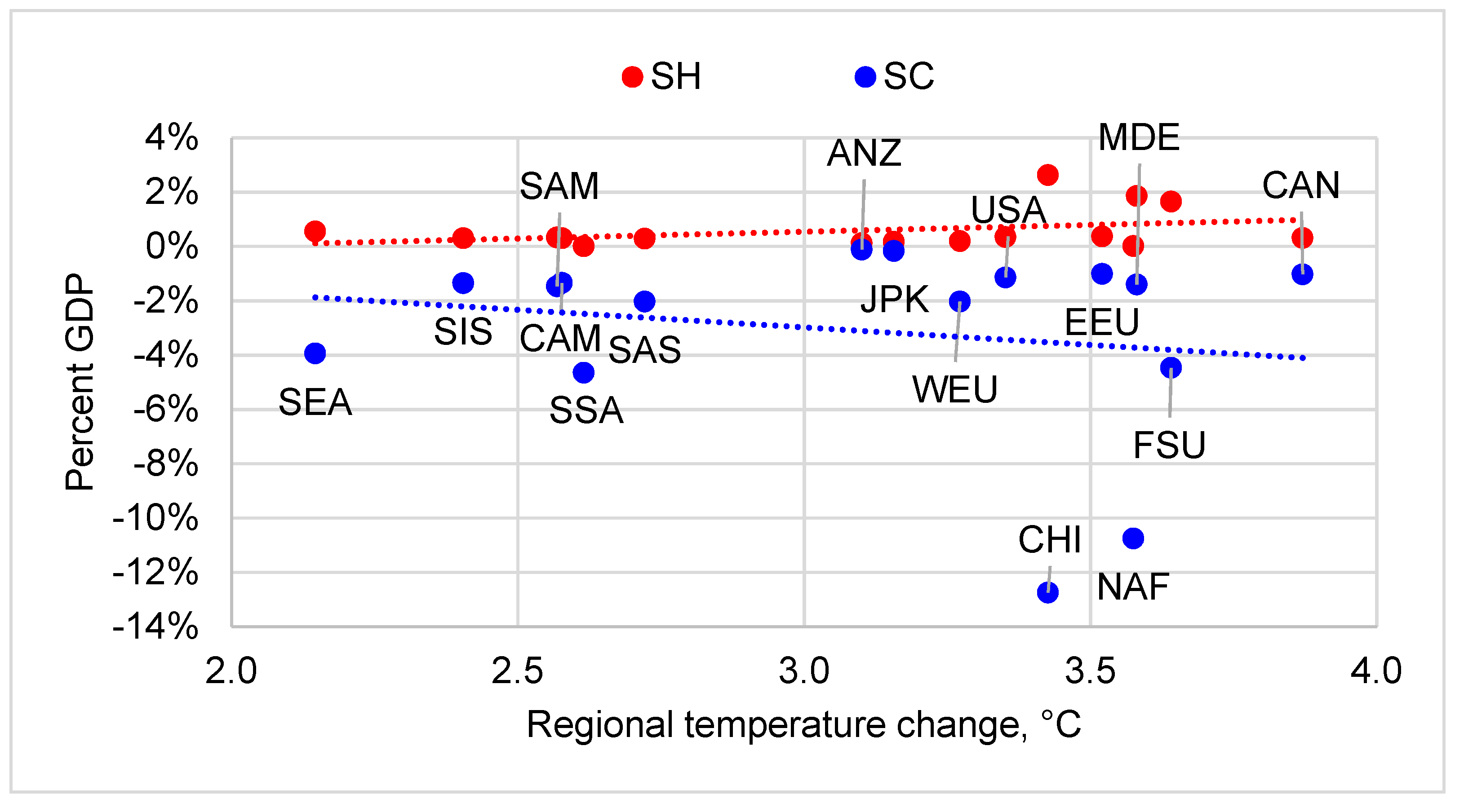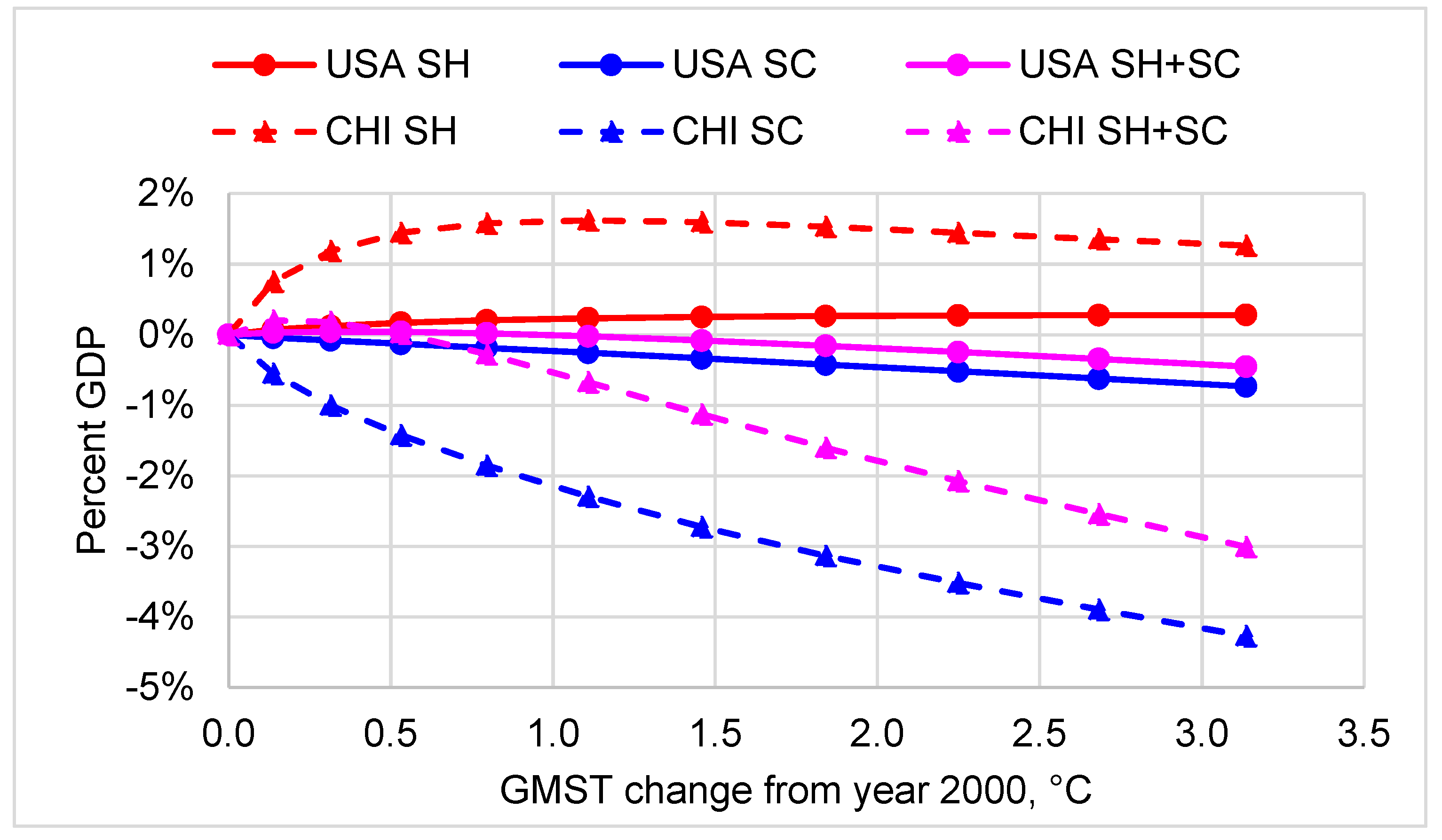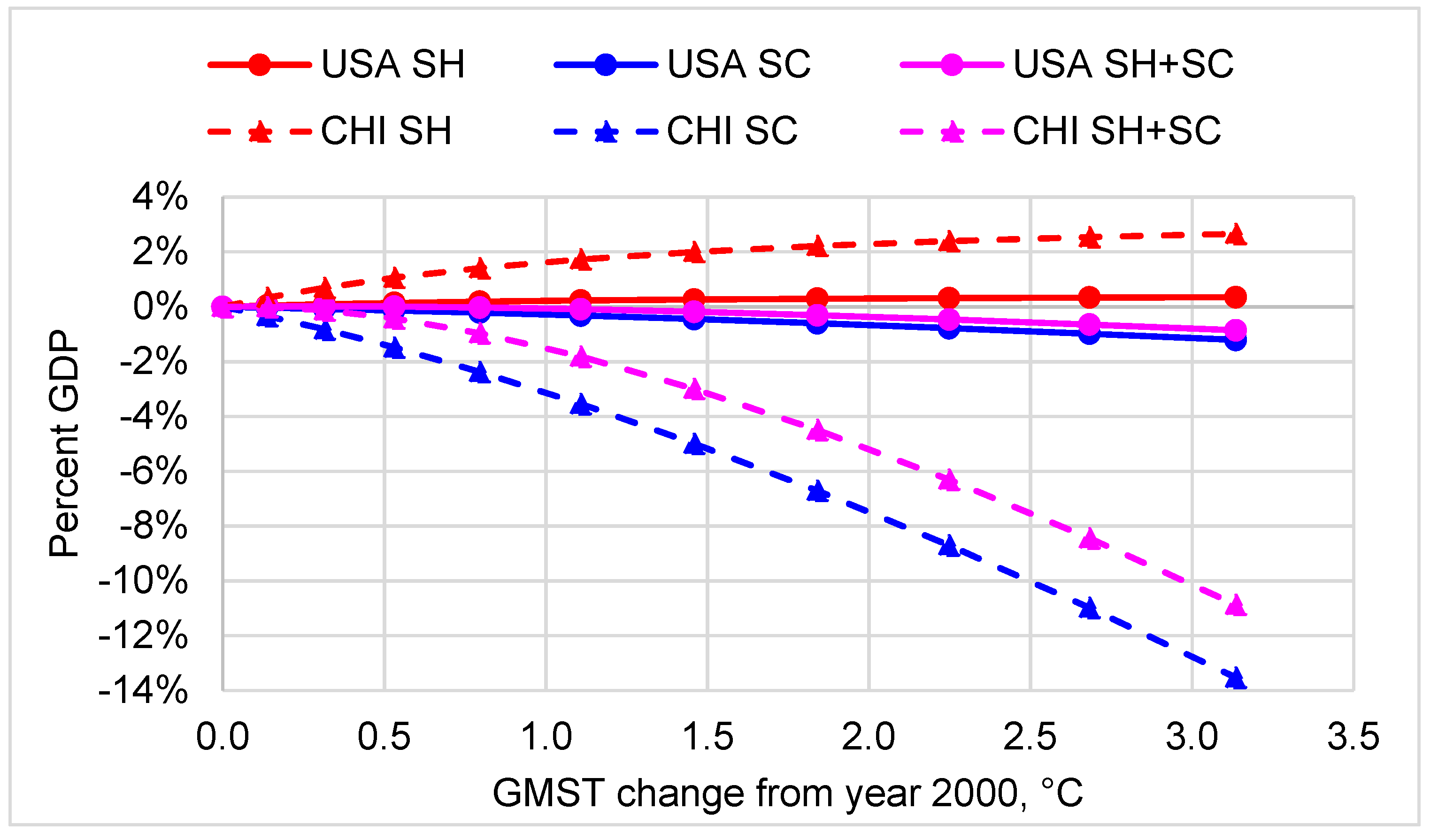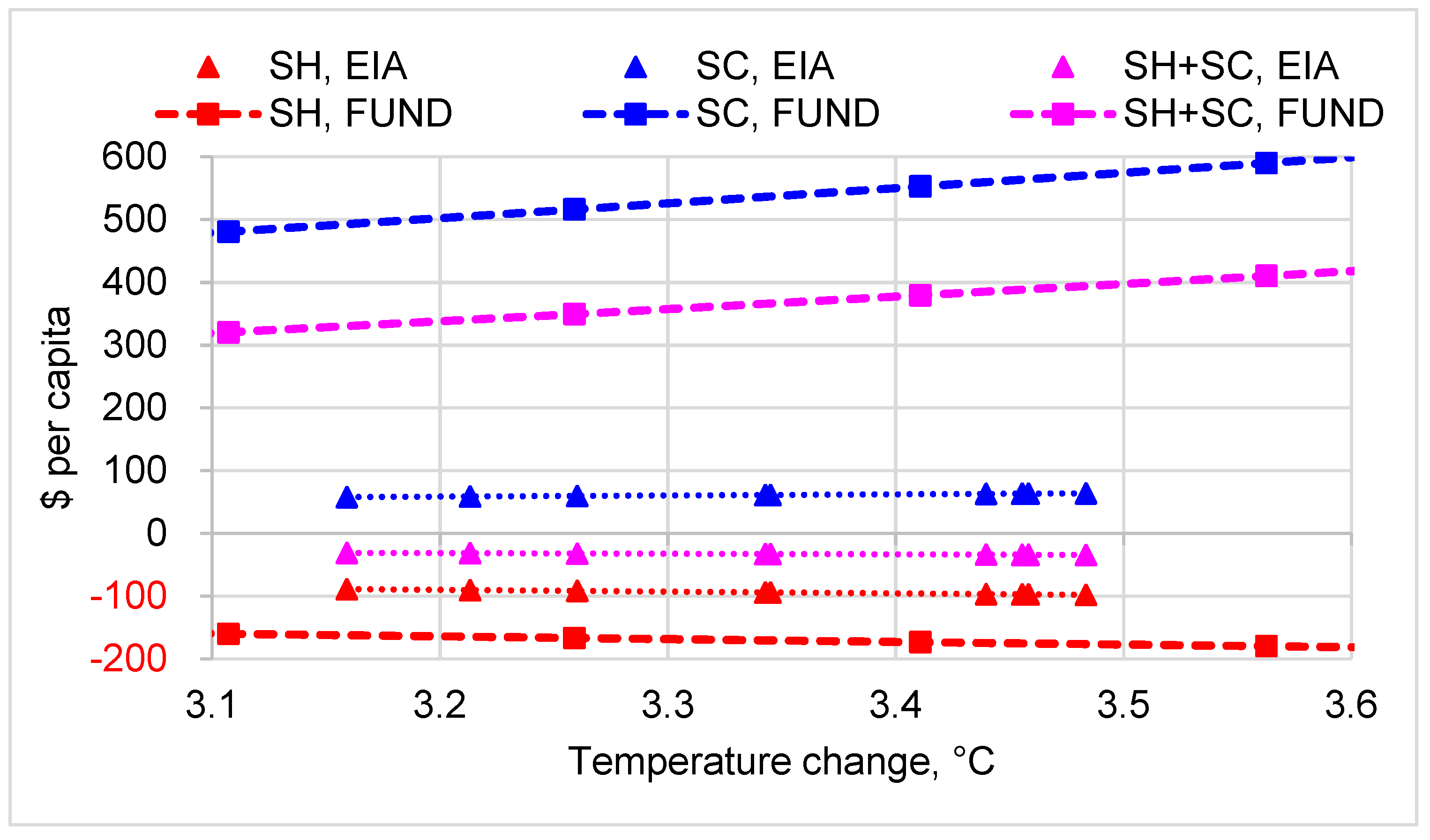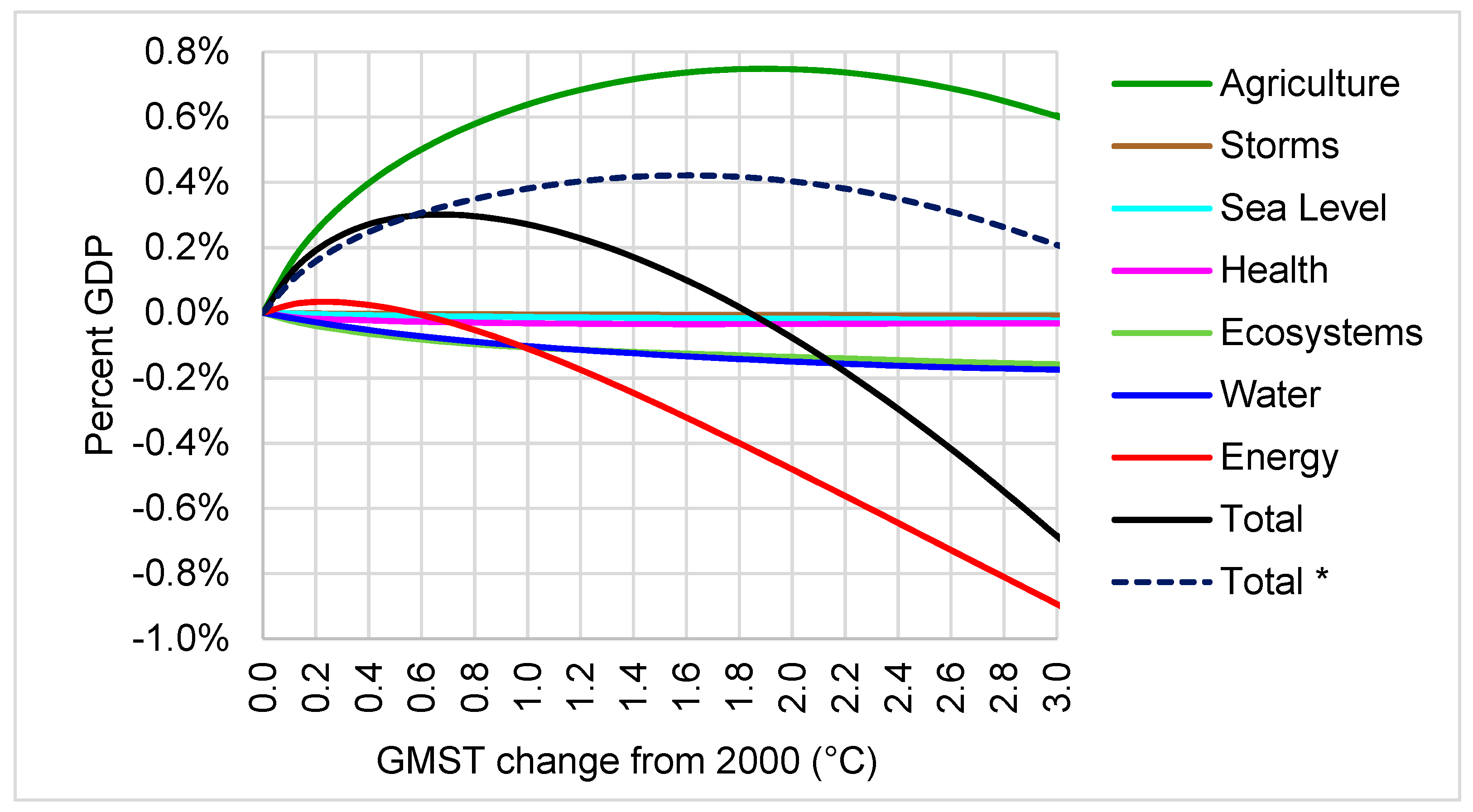1. Introduction
There is a scientific hypothesis and political acceptance [
1] that global warming of 2 °C or more above pre-industrial times would have a negative impact on global economic growth. This hypothesis is supported by economic models that rely on impact functions and many assumptions. However, the data needed to calibrate the impact functions is sparse, and the uncertainties in the modelling results are large [
2,
3]. The negative overall impact projected by at least one of the main models, Climate Framework for Uncertainty, Negotiation and Distribution (FUND) [
4], is mostly due to one impact sector – energy consumption. However, the projected negative impact seems to be at odds with empirical data. If this paper’s findings from the empirical energy consumption data are correct, and if the impact functions for the non-energy sectors are correct, then the overall economic impact of global warming would be beneficial. If true, the implications for climate policy are substantial.
Integrated Assessment Models (IAM) approximately reproduce the projections from the Global Climate Models (GCM) and apply impact functions to estimate the economic impacts of global warming. The impact functions are derived from and calibrated to what the developers assess are the most suitable studies of the impacts. The impact functions require many assumptions, including projections of population, gross domestic product (GDP), per capita income, elasticities and technology progress in energy provision.
Various studies conclude that the impact functions (also called damage functions) used in the IAMs are derived from inadequate empirical data. For instance, Pindyck [
5] (p. 11) says “when it comes to the damage function, however, we know almost nothing, so developers of IAMs can do little more than make up functional forms and corresponding parameter values. And that is pretty much what they have done.” According to Kolstad et al. [
2] (p. 258), the IAM damage functions “are generated from a remarkable paucity of data and are thus of low reliability”. The National Academies of Sciences, Engineering and Medicine (NAS) [
3] (p. 261) says FUND [
4] needs further justification for the damage functions, the adaptation assumptions for the different sectors, the regional distribution of damages, and the parametric uncertainties overall. Tol [
6] says the impact of climate change has not received sufficient attention; he says “there is either very little solid evidence, no conclusive evidence, or no quantification of welfare impacts”.
NAS [
3] reviews the damage functions of the three main IAMs, discusses alternative approaches, reviews recent literature on damage estimation, and offers recommendations for a new damage module. It says that much of the literature on which the damage functions are based is dated and, in many cases, does not reflect recent advances in the scientific literature. For example, the FUND energy impact parameters are calibrated to reproduce the results of the 1996 papers by Downing et al. [
7,
8] and the income elasticity results of the 1995 paper by Hodgson and Miller [
9].
FUND [
4] is one of the three most cited IAMs; Bonen et al. [
10], National Research Council [
11] and NAS [
3] compare them. FUND is the most complex. FUND disaggregates by sixteen world regions and eight main impact sectors (agriculture, forestry, water resources, sea level rise, ecosystems, health, extreme weather, and energy consumption). This enables analysts to conduct sensitivity analyses and to separately test individual impact functions.
Tol [
12] used the national version of FUND3.6 to backcast the economic impact of global warming for these sectors for the 20th century and projected the impacts for the 21st century. Tol fitted the backcast results to observations of 20th century sectoral impacts (Tol [
13]). Tol [
12] is an important study because it estimates the impacts for the most significant impact sectors, globally and by region. It also estimates the total impact on all sectors.
Figure 1 (adapted from Figure 3 in Tol [
12]) shows the backcast (observed) and projected economic impact of global warming by sector. (We have added the ‘Total’ and ‘Total*’ lines. ‘Total’ is digitized from Tol [
12] Figure 2. ‘Total*’ is the sum of all the backcast (observed) historical impacts from 1900 to 2000, and all projected sectoral impacts except energy from 2000 to 2100).
The bottom panel of
Figure 1 suggests that an increase of up to around 4 °C Global Mean Surface Temperature (GMST) above pre-industrial times would be beneficial for the total of all sectors if the projected energy impacts for 2000–2100 are excluded. Energy consumption is projected to have a substantial negative impact during the 21st century; in fact, its negative impact exceeds the total impact of all other sectors, which is positive, from about 2080.
The striking change in trend of the energy impact at the turn of the century inspired this study. The trend was positive as GMST increased by 0.61 °C during the 20th century [
13] but FUND projects it will be substantially negative for the 21st century as GMST is projected to increase further. That is, whereas the observations for 1900–2000 show the impacts were positive, FUND projects continued global warming would have negative impacts for the global economy.
Contrary to the FUND energy projection for the period 2000–2100, the US Energy Information Administration (EIA) [
14,
15] empirical data appear to indicate that global warming would reduce US energy expenditure and, therefore, contribute positive economic impacts for the USA. The paper infers that the impacts of global warming on the US economy may be indicative of the impacts on the global economy.
If the economic impact of energy is near zero or positive, and if the total of the sectoral projections in
Figure 1, other than for energy consumption, is approximately correct, global warming would be beneficial up to around 3 °C relative to 2000, and 4 °C relative to pre-industrial times. The significance of these findings for climate policy is substantial. For instance, policies that aim to reduce global warming would not be economically justifiable. Therefore, the economic impact of energy consumption projected in Tol [
12], and by FUND3.9, warrants investigation if FUND is to be used for policy.
This paper tests the validity of the FUND energy impact functions against US empirical data. It examines EIA data for the USA to investigate whether the impact of global warming on US energy consumption would reduce or increase US economic growth and compares the results with the energy projections. Next it investigates the projections for FUND’s 16 world regions. Lastly, it discusses some policy implications.
4. Discussion
Our findings suggest the FUND energy impact functions may be misspecified. This section suggests modifications and recalibration of the FUND energy impact functions and discusses possible explanations for the misspecifications, the inferences regarding the impacts of global warming on the global economy and the policy implications of the study’s findings.
4.1. Suggested Modifications to Energy Impact Functions
Here we suggest a modified energy impact function for the linear regressions of the EIA data. It includes RTCF as a separate parameter, and does not include per capita income change or the non-linear heating and cooling temperature terms ‘atan (
T)/atan (1.0)’ and ‘(
T/1.0)
β’. The impact of temperature change on US residential plus commercial heating and cooling expenditure, with non-temperature drivers at 2010 values, is given by the equation:
where:
Impact is energy expenditure change (in 2010 US$)
α (heat) = –28.14 ($ per capita per °C change at the population centroid)
α (cool) = 18.29 ($ per capita per °C change at the population centroid)
T = GMST change (from 2000)
F = RTCF (at the population centroid)
P = Population (2010)
This equation and the parameter values are for the USA only (population centroid latitudes 28° to 45°N). It would need to be generalised to be applicable for all world regions, latitudes and projection periods.
We suggest that:
The FUND energy impact functions and parameters be updated using best available empirical data.
RTCF be included as an explicit user-definable input parameter in the energy impact equations
FUND be modified to facilitate user input of parameters, including RTCF, so that users can test the calibration and conduct sensitivity analyses of the impacts of each of the parameters.
FUND be modified to enable analyses with non-temperature drivers held constant for any and all impact sectors.
4.2. Parameter Calibration
The FUND energy impact functions are calibrated to Downing et al. [
7,
8]. Downing et al. [
7] conclude that the increased cooling demand is much less than the reduced heating demand, implying that the economic impact of global warming on energy consumption would be positive. This conclusion is consistent with our findings for the US from the EIA data, but seems at odds with the negative economic impact projected by FUND.
4.3. Impacts due to Non-Temperature Drivers
The proportion of the projected energy impacts due to non-temperature drivers, at +3 °C GMST change from 2000, is 37% for the USA, 75% for CHI and 67% for the World (
Table 4). That is, two thirds of the projected global impacts of 3 °C global warming on energy consumption are due to non-temperature drivers. Similarly, Downing et al. [
7] and Waite et al. [
25] find that per capita income is a more significant driver of energy consumption change than temperature. Downing et al. [
7] conclude that cooling demand is more dependent on increasing per capita income than on temperature change, whereas heating demand is relatively insensitive to increasing per capita income.
Waite et al. [
25] studied urban electricity demand for heating and cooling in 18 OECD and 17 non-OECD tropical and sub-tropical cities. They found increasing energy demand as the cities become more urban, industrial and affluent. Mature urban OECD economies exhibit a cooling electricity response that is 10 to 17 times higher, per °C per capita above room temperature, than in non-OECD tropical and subtropical cities, indicating significant electricity demand growth as air conditioning is adopted. Electricity demand for heating is also increasing in subtropical areas as people are adopting electric resistance heaters. These electricity demand increases are mostly due to increasing affluence, urbanisation and industrialisation, not global warming. However, FUND regions with population centroids south of 30° N produced only 18% of global GDP in 2010, so their impact is a relatively minor contributor to the global impacts of warming.
4.4. Curvature of Heating and Cooling Demand as a Function of Temperature
Regarding the curvatures of heating and cooling demand as a function of temperature, the FUND documentation [
19] says that savings on heating are assumed to saturate whereas cooling is assumed to accelerate as it gets warmer. However, the EIA data show that both heating and cooling expenditure are near linear against temperature for the USA. Although the EIA data does not show the curvature over the temperature range analysed (i.e., 6 °C to 22 °C) (
Section 3.1 and
Appendix B), projection of the EIA data to higher temperatures indicates that heating expenditure flattens at average temperatures above 22 °C. DePaula and Mendelsohn [
26] and Waite et al. [
25] find that cooling expenditure will increase significantly in the tropics, but this is mostly due to increasing per capita income rather than temperature change.
4.5. Impact of Warming on Electricity Demand in Europe
A recent study indicates that the FUND energy impact functions may also be misspecified for Europe. FUND projects that the impacts of +2 °C global warming on energy consumption in WEU+EEU, with non-temperature drivers constant at 2010 values, would be –1.0% of GDP. However, consistent with our findings from the EIA data, Damm et al. [
27] conclude that +2 °C global warming would reduce electricity consumption in Europe. They explain that the reduced heating electricity demand outweighs the increase in cooling demand. They studied the impact of 2 °C warming on electricity consumption in 26 European countries using a method somewhat similar to ours in that it assumes present demographic and economic structures; that is, the non-temperature drivers are constant at current levels. However, their study does not report energy expenditure or economic impact, and analyses electricity only, not the other heating energy carriers (natural gas, oil, propane, coal, biofuels, and district heat). If the other energy carriers were included, the reduction in heating expenditure, and in heating plus cooling expenditure, with increasing temperature would be greater, which means the economic impact of global warming on energy consumption in Europe would be more positive (i.e., more beneficial).
4.6. Economic Impact of Global Warming on Global Energy Consumption
We infer that the findings for USA and Europe may be indicative of the impact of global warming on the global economy because these regions span the latitudes where most of the world’s GDP is produced. In 2010, USA, WEU and EEU produced 51% of world GDP; these regions plus CHI produced 60%; FUND regions with population centroids north of 30°N produced 82% [
18]. With non-temperature drivers constant at 2010 values, FUND projects the impact of +3 °C GMST to be –0.80% of GDP for the USA, –1.78% for WEU+EEU, and –10.12% for CHI. However, the EIA data indicates the impact for the USA to be +0.07%. The projected impact for WEU+EEU at +2 °C GMST is –0.99%, whereas Damm et al. find the impact of +2 °C GMST on electricity consumption in the 26 European countries would be positive. If the other heating fuels were included, the impact would be more positive. Since CHI is at similar latitude to USA and Europe, we might expect the impacts due to temperature alone might also be positive. In short, we infer from these figures that positive impacts of global warming in regions that produce 82% of world GDP are likely to exceed negative impacts in tropical countries. In this case, the impact of +3 °C GMST on energy consumption would be positive for the global economy.
The FUND energy impact functions are the same for all regions; only parameter values vary by region. Thus the findings that the FUND projections may be pessimistic compared with the results of studies of empirical data for the USA and Europe suggest that the energy impact functions may be misspecified for other regions. For example, at +2 °C GMST with non-temperature drivers constant at 2010 values, the projected impact for WEU+EEU (–0.99%) is more negative than for the USA (–0.37%). Since WEU+EEU’s population centroid is about 10° north of USA’s (
Table 3), we might expect the impacts to be more positive for WEU+EEU than for the USA. That FUND projects the opposite is another indication that the impact functions may be misspecified.
4.7. FUND3.9 Projected Global Sectoral Impacts of Warming
Figure 15 plots the global economic impacts by sector as a function of GMST change from 2000 to 2100 projected by FUND3.9 with non-temperature drivers included. The total of all impact sectors, and the total excluding energy, are also shown.
With energy impacts excluded, FUND projects the global impacts to be +0.2% of GDP at 3 °C GMST increase from year 2000. With the energy impact functions misspecifications corrected, and all other impacts are as projected, the projected total economic impact may be more positive.
The conclusion that 3 °C of global warming may be beneficial for the global economy depends, in part, on the total of the non-energy impact projections being correct, or more positive. Whether this is the case needs to be tested.
4.8. Policy Implications
The economic impact of climate policies is likely to be substantial. It is the sum of the economic impact of the policies and the cost of implementing and maintaining the policies. If global warming is beneficial, as this study indicates may be the case, then the total economic impact is the sum of the forgone benefits of the avoided global warming plus the cost of policies to mitigate warming.
Our analysis suggests that the overall impact of global warming may be positive—that is, it would increase global economic growth. If this is correct, then the positive impacts can be maximised and the negative impacts minimised by increasing wealth, but not by reducing global warming. Tol [
6] concludes that the negative impacts of global warming can be reduced by reducing global warming and/or reducing poverty. However, if global warming is beneficial, then polices aimed at reducing global warming are reducing global economic growth.
According to Lomborg [
28] any reductions in temperature resulting from the Paris Agreement promises would be minimal but at high cost. For example, Lomborg says that all Paris promises 2016–2030 will reduce global temperatures by just 0.05 °C in 2100, and by 0.17 °C if they continue to 2100. He estimates the most likely cost would be
$1,848 billion per year in 2030. This is about 2% of projected world GDP in 2030 [
20], and this estimate does not include all costs of the climate change industry.
Other studies also indicate that the cost of policies to reduce global warming is high. For example, Climate Change Business Journal [
29] estimates put the climate change industry in 2013 at
$1,405 billion, about 1.9% of world GDP [
18,
21]. Further, Insurance Journal [
30], citing [
29], says that the ‘climate change industry’ grew at 17–24% annually 2005–2008, 4–6% following the recession, and 15% in 2011. These growth rates are much higher than the growth rate of the world economy implying that, if they continue, which is likely with international protocols, accords and agreements such as Kyoto [
31], Copenhagen [
32] and Paris [
1], the cost of climate policies will continue to escalate.
5. Conclusions
This study tests the validity of the FUND energy impact functions by comparing the projections against empirical space heating and space cooling energy data and temperature data for the USA. Non-temperature drivers are held constant at their 2010 values for comparison with the empirical data. The impact functions are tested at 0° to 3 °C of global warming from 2000.
The analysis finds that, contrary to the FUND projections, global warming of 3 °C relative to 2000 would reduce US energy expenditure and, therefore, would have a positive impact on US economic growth. FUND projects the economic impact to be −0.80% of GDP, whereas our analysis of the EIA data indicates the impact would be +0.07% of GDP. We infer that the impact of global warming on energy consumption may be positive for the regions that produced 82% of the world’s GDP in 2010 and, by inference, may be positive for the global economy.
The significance of these findings for climate policy is substantial. If the FUND sectoral economic impact projections, other than energy, are correct, and the projected economic impact of energy should actually be near zero or positive rather than negative, then global warming of up to around 3 °C relative to 2000, and 4 °C relative to pre-industrial times, would be economically beneficial, not detrimental.
In this case, the hypothesis that global warming would be harmful to the global economy this century may be false, and policies to reduce global warming may not be justified. Not adopting policies to reduce global warming would yield the economic benefits of warming and avoid the economic costs of those policies.
The discrepancy between the impacts projected by FUND and those found from the EIA data may be due to a substantial proportion of the impacts (37% for the US and 67% for the world) being due to non-temperature drivers, not temperature change, and to some incorrect energy impact function parameter values.
We recommend that the FUND energy impact functions be modified and recalibrated against best available empirical data. Further, we recommend that the validity of the non-energy impact functions be tested.
This study is the first to test the FUND energy impact functions against observed data for the US showing that this function overstates damages due to global warming.
